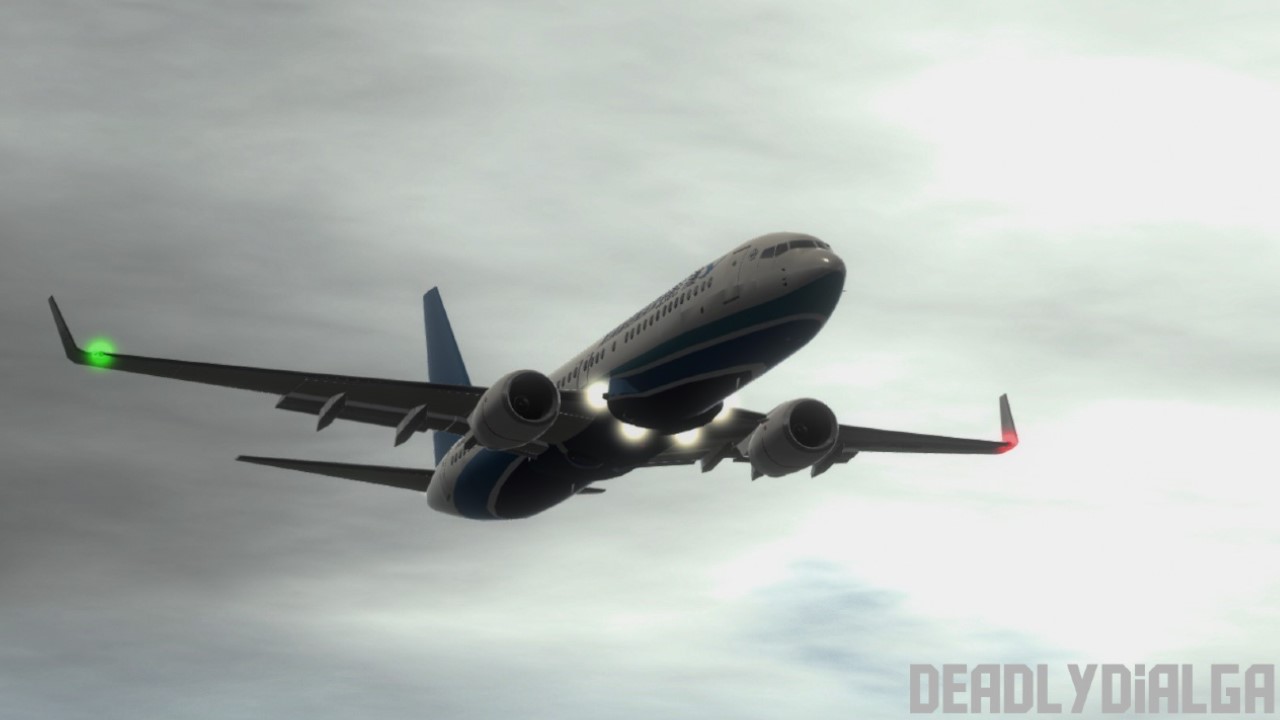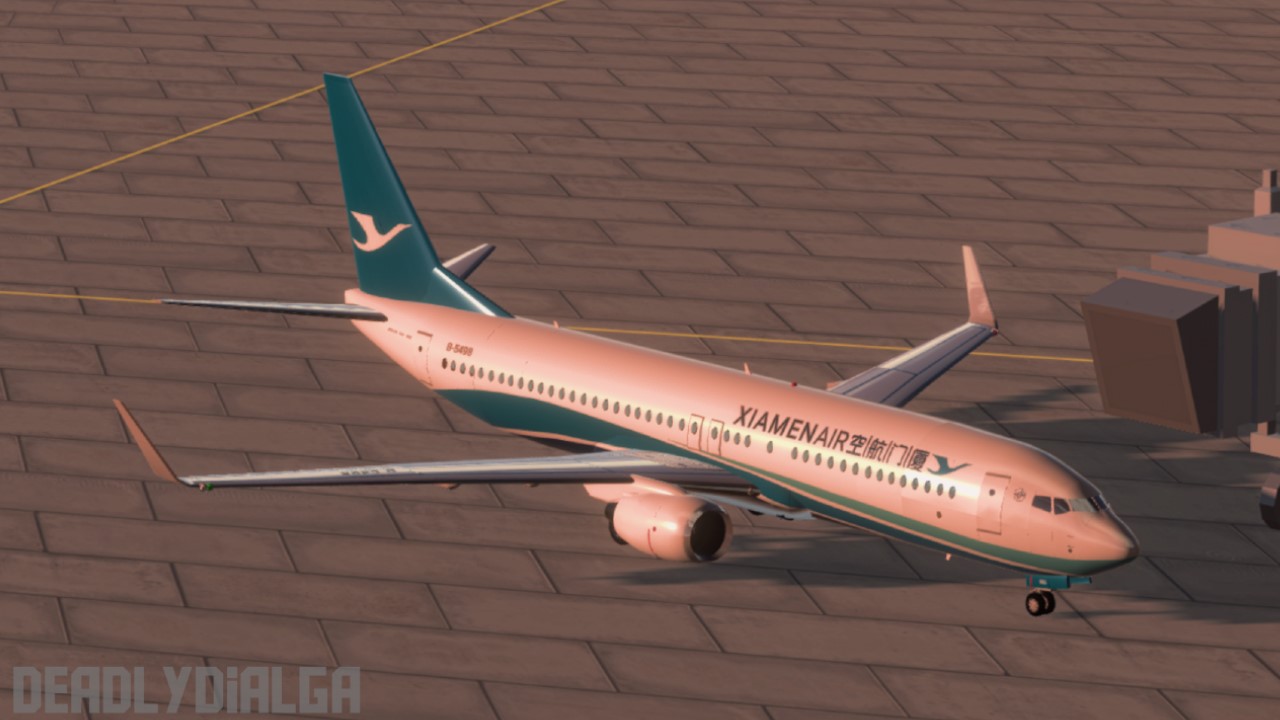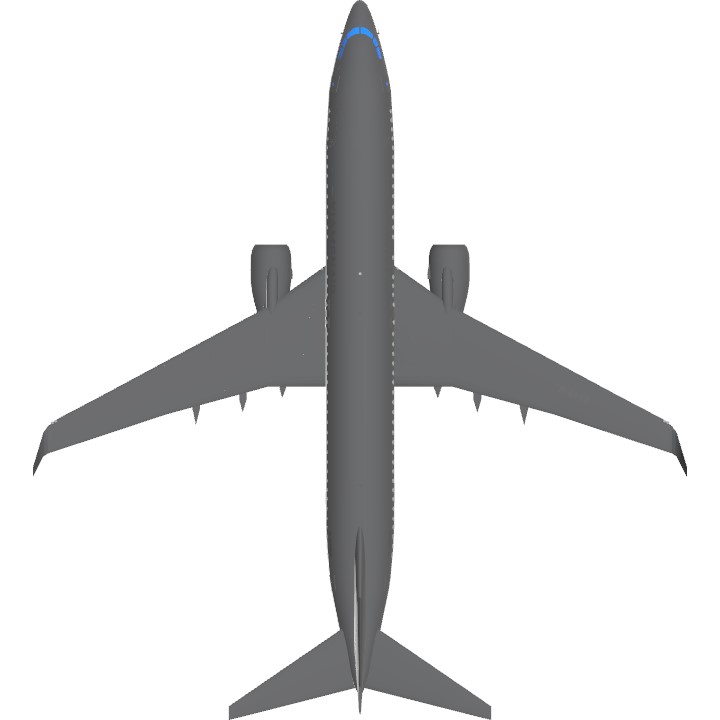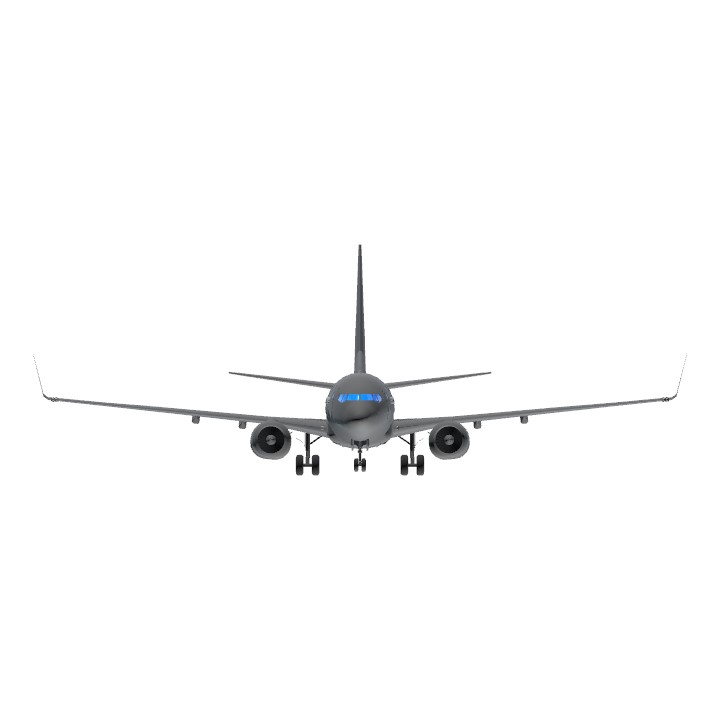Yes the thumbnail isn't great. Graphic design is not my passion.
Instructions listed in game
Original Creator Credits:
Original aircraft from GalacticaAsia's Boeing 737-800W
Cockpit interior parts from RealSavageMan's Boeing 737MAX-8 Southwest
Skyteam Logo from CRJ900Pilot
About the Boeing 737-800
Note: I've already covered the 737-700 and the brief history of the 737 here
The Boeing 737-800 is the best selling version of the Boeing 737NG family, which includes the -600, -700, and -900. The Boeing 737-800 is a stretched version of the 737-700 and was designed to replace the 737-400. Following the 1997 Boeing-McDonnell Douglas merger, the 737-800 also served to replace the MD-80 and MD-90 following the discontinuation of the aircraft types.
As with the other members of the NG family, she is powered exclusively by two CFM International CFM56 engines. The 737-800 seats 162 passengers in a two-class layout or 189 passengers in a one-class layout. The development of the -800 began on September 5th, 1994 and first flew on July 31st, 1997. She received FAA certification on March 13th, 1998 and one month later, the first 737-800 was delivered to launch customer Hapag-Lloyd Flug. Her main competitor is the Airbus A320 family. As of May 2019, Boeing had delivered 4,979 737-800s, making it not only the best selling variant of the 737NG, but the most widely used narrow body jet with her largest operator being Ryanair. Two other variants of the 737-800 are available, those being the freighter BCF variant and the SF converted freighter variant. Other military variants such as the P8 Poseidon are also available. Production of the 737NG ended in 2019, with the last 737-800 delivered to KLM in December of 2019. Production of cargo and military variants continue though.

The 737-800 prototype, N737BX, wearing Boeing house colors landing at King County International Airport in Washington, US (IATA: BFI, ICAO: KBFI) on February 9th, 1998.

The 737-800 prototype having been delivered to launch customer Hapag-Lloyd Flug re-registered as D-AHFA taxiing at Edinburgh Airport (IATA: EDI, ICAO: EGPH) in Scotland on July 30th, 2002.

The last 737-800 to be built, PH-BCL, with operator KLM taking off at Amsterdam Schiphol Airport (IATA: AMS, ICAO: EHAM) in the Netherlands on July 19th 2021.

The cockpit of an American Airlines 737-800, N971AN, at Austin–Bergstrom International Airport, (IATA: AUS, ICAO: KAUS) in Texas, US, on November 29th, 2021.

The cabin of a Norwegian Air Shuttle 737-800, LN-NOB, at Oslo Airport (IATA: OSL, ICAO: ENGM) in Norway on January 26th, 2008.
737-800 Specs and Info
-Length: 129 ft 6 in/39.5 m
-Wingspan: 117 ft 5 in/35.8 m
-Height (Tail): 41 ft 3 in/12.5 m
-Max Range: 3,115nm/5,765 km
-Maximum Occupancy: 189 Passengers
-Engines: Two CFM International CFM56 high bypass turbofans
-Cabin Layout: Six abreast
Aircraft type designators
ICAO Code: B738
IATA Code: 738
About XiamenAir
IATA Code: MF
ICAO Code: CXA
Callsign: XIAMEN AIR
Primary Hubs: Xiamen Gaoqi International Airport (IATA: XMN, ICAO: ZSAM), Fuzhou Changle International Airport (IATA: FOC, ICAO: ZSFZ)
Headquarters: Xiamen, China
Years Active: 1984-Present

XiamenAir's logo since 2012

A XiamenAir Boeing 737-200, B-2510 wearing the original CAAC (Civil Aviation Administration of China) livery parked at Guangzhou Baiyun International Airport (IATA: CAN, ICAO: ZGGG) in May 1985. In 1990, this aircraft, operating as Flight 8301 was hijacked as subsequently crashed during a landing attempt at Guangzhou.

A XiamenAir 757-200, B-2819, wearing the 'Blue Sky with White Heron' livery taxiing at Hong Kong Kai Tak Airport on December 24th, 1996. This was XiamenAir's first 757-200 and the 100th Boeing aircraft delivered to China.

A XiamenAir A321neo, B-32CU, wearing the current 'One Heron Flying High' livery taxiing at Beijing Daxing International Airport (IATA: PKX, ICAO: ZBAD) on February 13th, 2023. Serving as XiamenAir's first non-Boeing aircraft, ending their near 40 year run of being an exclusive Boeing operator.

A XiamenAir 787-9, B-1356, wearing a special 'In Support of the UN' livery landing at Beijing Capital International Airport (IATA: PEK, ICAO: ZBAA) on March 29th, 2018.
"Xiamen Airlines, a member of the SkyTeam Alliance with an air carrier code of “MF”, has an annual passenger traffic volume of nearly 40 million passengers, attracts more than 10 million passengers on its frequent flyer program - Egret Miles. Xiamen Airlines currently operates around 350 domestic and international routes, which forms a network covering the entire China and with a strong presence in Southeast and Northeast Asia. In recent years, as new intercontinental routes to Amsterdam, Sydney, New York, Los Angeles, etc. were opened consecutively, our network has prospered and reached Europe, America and Oceania, and extended to all major destinations around the world via SkyTeam Alliance."
-XiamenAir
Xiamen Air is an airline based in Xiamen, China. Xiamen Air has its northern headquarters in Beijing and eight branches in Fuzhou, Hangzhou, Tianjin, Hunan, Beijing, Quanzhou, Chongqing and Shanghai, and two subsidiaries in Hebei Airlines and Jiangxi Airlines.
Founded on July 25, 1984, Xiamen Airlines is the first airline in China to operate independently as an enterprise. It was established as a joint venture between the Shanghai Administration of Civil Aviation Administration of China, Xiamen Special Economic Zone Construction Development Company and Fujian Investment Enterprise Company. Until 2023, XiamenAir operated an all Boeing fleet
Xiamen Airlines operates more than 320 domestic and international routes from Xiamen Gaoqi International Airport, Beijing Daxing International Airport, Fuzhou Changle International Airport and Hangzhou Xiaoshan International Airport, with 3,500 to 4,000 flights per week and nearly 25 million passengers per year. Xiamen Airlines is the 19th member of SkyTeam and the first airline in mainland China to join the world's three major airline alliances.
XiamenAir 8667: Domino Effect

The accident aircraft, B-5498, landing at Xiamen Gaoqi International Airport on July 23rd, 2017
(Obligatory not a real pilot or aviation expert disclaimer. This should not be used as a source for any coverage of the incident)
Thursday, August 16th, 2018.
A XiamenAir Boeing 737-800 registered as B-5498 is preparing for a regularly scheduled international flight from Xiamen Gaoqi International Airport in China to Ninoy Aquino International Airport (IATA: MNL/ICAO: RPLL) in the Philippines. The aircraft is eight years old, delivered new to XiamenAir on January 29th, 2010. She is equipped with two CFM International CFM56 engines as is standard for the 737NG. The total flight hours and cycles are not listed, but Flight 8667 regularly operated the Xiamen-Manila route daily. Onboard are 157 passengers and 8 crew for a total of 165 souls. In the cockpit is a 50 year old Captain with 16,000 hours of flight experience, 7,000 hours of those on the Boeing 737-800. He is acting as pilot flying for this flight. The first officer, acting as pilot monitoring, is a 28 year old male with 950 flight hours, 750 on the Boeing 737-800.
At 21:23 local time, Flight 8667 departs Xiamen for what should be another ordinary flight, which it is for the majority of the flight. Approaching Manila, the weather begins to deteriorate with thunderstorms and heavy rain in the area. The pilots are planning to land on Runway 24, but the aircraft enters a holding pattern for 14 minutes to wait for a break in the storm. A break in the storm presents itself and the rest of the approach is uneventful asides from intermittent, heavy rain. At 23:40 local time, the first landing is attempted, however because of the heavy rain the runway becomes obscured and just 30ft/9.144m above the ground a go around is initiated to an altitude of 4000ft/1219.2m flying the runway heading. In the cockpit, a brief discussion ensues debating if a second landing should be attempted or if the aircraft should fly to its planned alternate. The crew decides to attempt another landing and divert to their alternate should this one fail.

Ninoy Aquino Airport Chart. Flight 8667 is planning to land on RW24 on the right side of the chart.
Once again, the aircraft establishes itself back on the approach. The rain is heavy and visibility out the window is minimal but the approach continues. The gear are lowered, flaps extended to 30, and speed brakes are armed. On passing 1000ft/304.8m, the autopilot is disabled and three seconds later the autothrottle is disengaged. From here down to 50ft/15.24m, there are no deviations from the glideslope. In addition to the heavy rain, the high intensity centerline lights have been out for over a week for scheduled runway renovation, reducing visibility even further.
As the aircraft passes over the threshold of RW24, the aircraft is met with unexpected low level windshear, pushing the aircraft to the left of centerline. Noticing this, the F.O calls for a go around, which the Captain rejects. As the aircraft passes 13ft/3.96m, the F.O makes a second go around call which is again rejected. The aircraft touches down left of centerline 2,430 ft/741m from the threshold. Both speed brakes and autobrakes deploy normally but for unknown reasons the autobrakes disengage shortly after touchdown. According to witnesses, the aircraft bounces after its initial touchdown before touching down again and immediately veering to the left again. At a speed of 147 knots, the aircraft shoots off the runway and into the grass. In doing so the left side of the aircraft impacts several large concrete electrical junction boxes, causing the left main gear and the No.1 engine to be violently torn from the aircraft. The aircraft continues sliding, causing the right main gear to collapse and be forced back into its well, and the nose gear to be forced up into the avionics bay below the cockpit. Finally, at 15:55UTC/23:55 local time, at a distance of 260ft/79.2m left of the runway edge and 4,900ft/1,500m from the RW24 threshold, the aircraft comes to a stop. The nose wheel collapsing into the avionics bay disables both the internal and external communications, leading to both a failure of the PA system making an evacuation announcement from the cockpit impossible, as well as a cut in communications with ATC.

Rough map of aircraft and wreckage

The No.1 engine

Aircraft wreckage at night

Daytime view
Following the lack of communication, tower controllers dispatch the airport safety patrol to survey the runway where they find the aircraft. Runway 06/24 is declared closed and twelve minutes after the accident, airport police and fire/rescue secure the site and are able to account for all 165 passengers and crew. Other than superficial scratches, no injuries are reported. Passengers are bought into Terminal 1 and provided blankets and water. Two hours later, a Civil Aviation Authority of the Philippines led investigative team arrive, setting up a mobile command center around the site. Throughout the night workers recover the flight data recorders and unload the cargo.

Daytime view of wreckage with the command center
The issues begin here. First and foremost, according to international aviation laws set by ICAO which states that in order for an airstrip to operate, no hazards can be located within 490 ft/ 150 m of either side of a runway. The aircraft sits roughly 80 meters left of the runway. This, combined with the presence of debris on the runway forces the closure of RW06/24, causing the cancellation of over 200 domestic and international flights, and the diversion of 17 inbound flights. RW06/24 serves as the main runway for NAIA, handling widebody jets from international flights. The other runway is 13/31, or the domestic runway which is only 8,500ft/2,600m long and 150ft/45m wide, unable to handle widebody international traffic. As such in the immediate aftermath, in the four terminals of NAIA, some 40,000 passengers are now stranded. Countless passengers attempt to make arrangements for alternative flights against the relatively few employees, and with airlines being unable to tell when operations will resume, the airport becomes little more than a sardine can as the terminals are packed full of people and horror stories quickly emerge. Frustrations quickly reach a fever pitch, and the airport and its management are heavily criticized and accused of not having an emergency plan, safety protocols, or necessary equipment to quickly deal with emergency situations, as well as not attending to the needs of stranded passengers.
By 06:10 local time, the initial investigation was complete and cleanup operations could begin. With the aircraft thoroughly stuck in mud, the initial plan is to place airbags under the aircraft and inflate them, raising it out of the mud. The gear would then be lowered and the aircraft towed to a safe space. Upon raising the aircraft from the mud however, the extensive damage to the landing gear was discovered. With the fuel pump damaged, some four tons of fuel are also left inside the aircraft with no way to be removed. Another way to move the 737 was needed. Workers on site opted to use a crane, and airport authorities rent a telescoping crane from a nearby cargo yard. During this time however, the muddy terrain along with continuous intermittent and heavy rain and lightning hinders operations. In total, it takes 26 hours to finally remove the aircraft where it is placed on the ramp near Terminal 3.

Removal of the left main gear

The No.1 engine being taken away on a flatbed

The aircraft being secured to the crane

The aircraft being set down on the ramp

The full wreckage detached from the crane
Finally, at 11:36 on August 18th, around 36 hours after the incident, RW06/24 is reopened, though due to the large amount of passengers having cancelled flights, a domino effect begins of airlines cancelling flights. In those 36 hours, an estimated 250,000 people are affected by the runway closure due to delays, cancellations, and diversions. Once operations resumed, XiamenAir states that they would send several planes to Manila within the day to transport the nearly 2,000 XiamenAir passengers that had been stranded at the airport. CAAP officials announced that the pilot and the first officer of Flight 8667 had been barred from leaving the country pending the results of the accident investigation and that criminal charges were possibly being pursued. though a CAAP representative later stated that both were allowed to leave the country in the last week of August.
Four days later, XiamenAir issued a statement apologizing to the passengers affected by the incident and pledged to assist Philippine authorities. The airline also agreed to pay the costs of removing the aircraft and provided more than 55,000 meals and water to the travelers that had been impacted by the closure of the airport. Following this, airport authority stated that XiamenAir would have to pay the airport $280,000USD/15 million Pesos. Cebu Pacific and Philippine Airlines also considered filing lawsuits against XiamenAir for lost revenue. The total incurred fines for XiamenAir reached $630,000USD/33 million pesos, though the total costs to the Philippine Economy sustained in the 36 hour period and the aftereffects reached an estimated staggering 43 million USD/2.27 billion pesos.
The final reports states the primary cause of the accident to be "the decision of the Captain to continue the landing on unstabilized approach and insufficient visual reference." Contributing to this was the lack of CRM and the failure of the crew to discuss strategies for dealing with inclement weather, and failing to address the possibility of low level wind sheer as well as the fact that the runway lights were out as stated in NOTAMs. As a result, As a result of the accident, XiamenAir revised their flight crew policies on how to handle go-around situations, adding training for rainy and wet runways during nighttime operations to its Boeing 737 training program. Policies were also amended to prohibit takeoffs and landings during heavy rains and prohibited landings in moderate rains during night flights when the runway center line light is not working or not available. Officials at the airport also performed upgrades to the runway to remove the concrete electrical junction box obstructions. The accident also called for an expansion of the airport or to construct/expand additional airports in the region to prevent similar economic disruptions if a similar incident were to occur in the future.
The aircraft itself, B-5498, was deemed a write off and was subsequently scrapped on site.



The aircraft being disassembled and scrapped
Personal Notes
So uhhh... I didn't think things could get any more scuffed than the Atlasjet MD-83 but it seems the universe has a way of showing me that things can always get worse. Started working on this last semester, but unfortunately I had made a great enemy that would stop at nothing from depriving me of any free time. This enemy was named 'Philosophy' and it was a painful experience. When I did have free time, I was trying to find ways to do the Chinese text. Initially, I tried my normal style of fuselage slicing but that quickly didn't work out. So I had to learn a new style on the spot. In the end, it turned out alright I guess. But things didn't end there, oh no.
Once the semester was finished and I was done with essay mania and at home, I planned to knock out the post before Christmas. The problem was I was so tired that by the time I sat down to finish things up, take screenshots, and write the post, I just fell asleep. And then my computer started to break down so I had to go get that sorted out. I did get the initial post done and screenshots taken before Christmas where I uploaded it as an unlisted. From there, I was on vacation in Brazil for two weeks. I had planned there to work on writing the post from my phone but it quickly became very clear that that was not feasible. On the way home, I decided to use my Switch which I hadn't used in a bit and remembered what it was like to play something other than SP, and got carried away. Then I remembered that I still had to finish this, and one month after posting the teaser, I'm done.
Assuming this gets me to 10K, then let me tell you. Big things are coming. I have plans that I cannot disclose at this time. Until then, you'll have to wait (assuming you've even read this far). Otherwise thanks for being patient, happy new year, and as always enjoy and safe flying!
-DeadlyDialga
Edit 10/30/24: Wow I did this 9 months ago? I promise, I still have something on the way (or rather in the very early stages), I just need to find my motivation again.
Additional Resources
Final Report
ASN Entry
ATC Audio
Reuters News Article
Aviation Herald Article
Footage from onboard
Specifications
Spotlights
- RicardoACE 1.9 years ago
- Inuyasha8215 1.9 years ago
- DISHWASHER2005 1.9 years ago
- Pan 1.9 years ago
- LtSaturn 1.9 years ago
- 929 1.9 years ago
- YarisSedan 1.9 years ago
- JP11 1.9 years ago
- CCCP0000001 1.9 years ago
- ChihiroFujisaki 1.9 years ago
- TheFlightGuySP 1.9 years ago
- Zerkk 1.9 years ago
- BluesynVN 5 months ago
General Characteristics
- Predecessor B737-800[W]
- Successors 3 airplane(s)
- Created On Windows
- Wingspan 117.5ft (35.8m)
- Length 129.4ft (39.4m)
- Height 41.5ft (12.6m)
- Empty Weight N/A
- Loaded Weight 42,551lbs (19,301kg)
Performance
- Power/Weight Ratio 0.981
- Wing Loading 23.9lbs/ft2 (116.8kg/m2)
- Wing Area 1,778.2ft2 (165.2m2)
- Drag Points 17295
Parts
- Number of Parts 1532
- Control Surfaces 9
- Performance Cost 5,431







BUG FIXED VERSION
Low Part Version
Comments Link
@DeadlyDialga hello bro
@Aisienchik06087
At the moment I have no plans to make anything. I’m busy with my job so the free time I get I spend doing other stuff.
I’ll probably do some stuff again once SP2 fully releases and I’d like to try out some different things.
Hey deadlydialga can you make Kazakhstan Airlines il-76 mobile friendly pls
@DeadlyDialga I'm making all the liveries on mobile and my phone can't handle the parts, so, there's that too.
@TheD2O
Very much the same. I’ve since that last comment you responded to graduated from college and am now doing a job with animal care and education so I’ve been using my free time to do other stuff. As for my secret project, it’s not cancelled I’m just burnt out.
Oh and my computer is practically on its death bed so there’s that too…
@DeadlyDialga Still just as impressive as I remember, even better, perhaps. Meanwhile, I'm burnt out from school and I have no idea on what planes to use to make livery designs, nor what kind of livery I should use for said planes. So, I'm basically on an extremely long hiatus to the point where I could or couldn't quit.
@DatFiat126Guy19
Very busy. Regretfully I don’t get much free time so the project I’m currently working on… I uhhh… I haven’t made any real progress on in a hot minute :/
Doing alright otherwise.
@DeadlyDialga hey, me from a few months later, how's it been?
@DeadlyDialga can u give me ur discord? I just got an account
@JacksEpicGamingYT
When it's ready?
Bold of you to assume I'm even working on a plane.
@DatTrainGuy19
Appreciate it either way :)
@DeadlyDialga you know what, thats fair enough i guess, still think that you're underrated asf.
@DELTABallbilibili
Thank you :)
I’ve got things planned for the future. Was hoping this would take me to 10K but that didn’t happen so I’m doing one more thing before moving onto completing my first true build.
I am Chinese, and this is the best Xiamen Airlines 738 I have seen on the official website. Looking forward to the next work
Excellent work
@AeroflotBilibili
Again, appreciate the support from the Chinese community.
@NormalCv580enjoyer
I never leave. The process really goes like this
Rinse and repeat + a busy schedule means things I could get out in like two weeks take like two or three months. Even when I’m not doing anything in regards to builds/modifications, I’m still active on the site, on MP, and on SP discord servers.
@DatTrainGuy19
I dunno about that. At least you build stuff from the ground up so I’d say some points are well earned for you.
I once asked some friends how I could get more points and the main suggestion was to make forum posts. Unfortunately I don’t really have much to talk about/want to talk about the begin with so I never do that.
@cx332
Thanks. They were hell to make. Normally I use fuselage slicing to make text but with the way Chinese characters appear, the normal slicing I do with English characters didn’t work so I had to find a workaround. Took like three weeks to get right, especially with the curvature of the fuselage at the front.
@CR929thenewSPplayer
I appreciate the support from the Chinese community, that way I know I did something right :)
Something about the XiamenAir livery is very aesthetically pleasing, hence why I chose to do it.
WOW
i really like those Chinese characters you've made
As a Chinese player, I would like to say that’s the best one of the best xiamen airlines livery I ever seen in this website